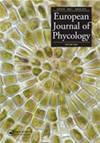toyamaparietochloris sp. 11 .和P. bilobata (Trebouxiophyceae)的超微结构和系统发育
IF 1.7
4区 生物学
Q2 MARINE & FRESHWATER BIOLOGY
引用次数: 1
摘要
摘要我们描述了toyamaensis Parietochliples sp.nov.,并通过超微结构和分子分析验证了毕氏疟原虫(最初被描述为Neochliples,曾与Ettlia结合)的分类地位。丰山P.toyamaensis是从日本丰山采集的土壤中分离得到的。它有一个带有蛋白核的顶叶叶绿体,这些蛋白核不连续地被淀粉段覆盖,并或多或少平行地被类囊体膜穿透,并通过形成裸露的、有点背中央的、双层状的游动孢子来繁殖。两个可收缩的液泡纵向排列,位于游动孢子的正中腹侧,如泡状P。基础器的组成部分包括右根中的单个微管。在18S rDNA和ITS2树中,P.toyamaensis与该属的其他成员分离。由于毕氏疟原虫的真实菌株ASIB V141(以Ettlia的形式储存)已经丢失,因此使用ASIB V143作为参考。毕氏疟原虫ASIB V143'在18S rDNA树中被解析为'严格意义上的Parietochloris'分支,而不是'Lophosphaera'分支,因此在分类学上证实了Andreyeva将毕氏疟原虫与Parietohloris组合为毕氏疟原虫。在毕氏假单胞菌的游动孢子中,收缩液泡位于腹侧,与肺泡假单胞菌一样。讨论了毕氏菌和大毕氏菌的分类学关系,以及对收缩液泡在背腔游动孢子中的独特位置的评价,认为收缩液泡是Parietochloris的关键特征之一。亮点利用超微结构和分子数据对八氯虫物种进行表征。toyamaensis Parietochliples sp.nov.毕氏Parietocchliples系统发育位置的验证。本文章由计算机程序翻译,如有差异,请以英文原文为准。
Ultrastructure and phylogeny of Parietochloris toyamaensis sp. nov. and P. bilobata (Trebouxiophyceae)
Abstract We describe Parietochloris toyamaensis sp. nov. and verify the taxonomic status of P. bilobata (originally described as Neochloris and once combined with Ettlia), using ultrastructural and molecular analyses. P. toyamaensis was isolated from soil collected in Toyama, Japan. It had a parietal chloroplast with pyrenoids that were discontinuously covered with starch segments and penetrated more or less in parallel by thylakoid membranes, and reproduced by forming naked, somewhat dorsoventral, biflagellate zoospores. Two contractile vacuoles were in line lengthwise, located in the median ventral side of the zoospores, as in the type P. alveolaris. The basal apparatus components included a single microtubule in the dexter root. P. toyamaensis was separately resolved from other members of the genus in the 18S rDNA and ITS2 trees. Since the authentic strain ASIB V141 of P. bilobata (stored as Ettlia) has been lost, ASIB V143 was used as a reference in place of it. P. bilobata ASIB V143 was resolved in the ‘Parietochloris sensu stricto’ clade but not ‘Lobosphaera’ clade in the 18S rDNA tree, so taxonomically the combination of N. bilobata with Parietochloris as P. bilobata by Andreyeva was confirmed. In zoospores of the strains of P. bilobata, contractile vacuoles were located in the ventral side, as in P. alveolaris. The taxonomic relationship between P. bilobata and P. grandis, and evaluation of the unique position of contractile vacuoles in dorsoventral zoospores as one of the key characters of Parietochloris were discussed. Highlights Characterization of the species of Parietochloris by using ultrastructural and molecular data. Proposal of Parietochloris toyamaensis sp. nov. Verification of phylogenetic position of Parietochloris bilobata.
求助全文
通过发布文献求助,成功后即可免费获取论文全文。
去求助
来源期刊

European Journal of Phycology
生物-海洋与淡水生物学
CiteScore
4.80
自引率
4.20%
发文量
37
审稿时长
>12 weeks
期刊介绍:
The European Journal of Phycology is an important focus for the activities of algal researchers all over the world. The Editors-in-Chief are assisted by an international team of Associate Editors who are experts in the following fields: macroalgal ecology, microalgal ecology, physiology and biochemistry, cell biology, molecular biology, macroalgal and microalgal systematics, applied phycology and biotechnology. The European Journal of Phycology publishes papers on all aspects of algae, including cyanobacteria. Articles may be in the form of primary research papers and reviews of topical subjects.
The journal publishes high quality research and is well cited, with a consistently good Impact Factor.
 求助内容:
求助内容: 应助结果提醒方式:
应助结果提醒方式:


